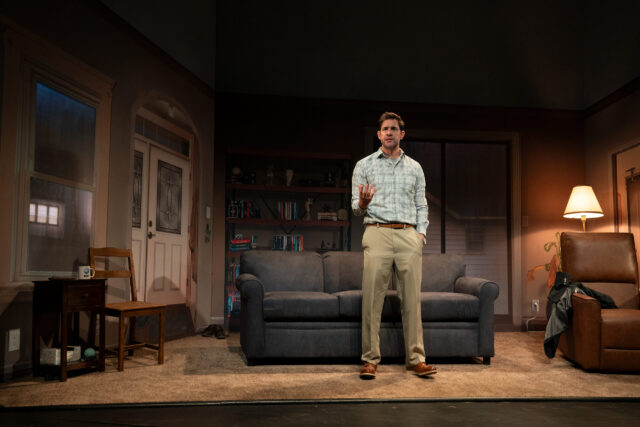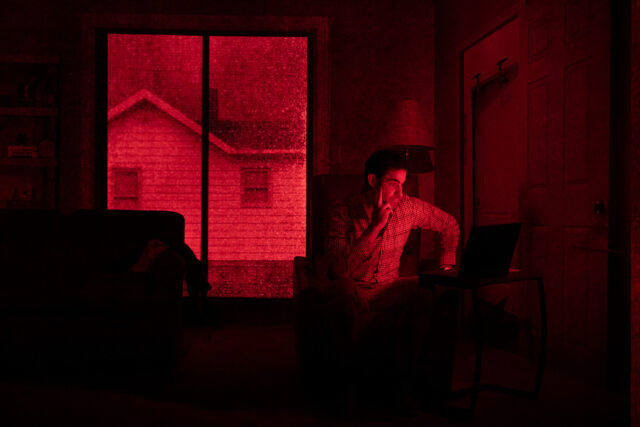
John Krasinski stars as a man descending into an internet rabbit hole in Angry Alan (photo by Jonny Cournoyer)
ANGRY ALAN
Studio Seaview
305 West 43rd St. between Eighth & Ninth Aves.
Through August 3, $69-$249
studioseaview.com
Angry Alan makes me angry. More on that later.
John Krasinski has made a career of playing likable characters. From Jim Halpert on The Office to Jack Ryan, A Quiet Place, and the web series Some Good News, Krasinski portrays amiable, trustworthy, and sensible men who are easy to identify with and root for.
That’s why he’s such a great choice to star as Roger in Penelope Skinner’s Angry Alan, the inaugural production at Studio Seaview in the former West Forty-Third St. home of Second Stage. Originally performed at the 2018 Edinburgh Fringe by cocreator Donald Sage Mackay as a one-hour solo show, Angry Alan has been expanded to eighty-five minutes and now has a second actor. More on that later.
On social media and various conspiracy sites, the terms “red-pilling” and “blue-pilling,” derived from the 1999 film The Matrix, refer to radicalization as a result of a sudden revelation of a hidden reality that is obscured by various elements of society that seek to repress or hold down humanity. Red pills are associated with conspiracy theorists and men, in particular. In the movie, Morpheus (Laurence Fishburne) offers Neo (Keanu Reeves) a choice: “You take the blue pill . . . the story ends, you wake up in your bed, and believe whatever you want to believe,” he says. “You take the red pill . . . I show you how deep the rabbit hole goes.”
A divorced father who lives with his girlfriend and rarely sees his teenage son, Roger essentially chooses the red pill after he loses his prestigious job at AT&T, becomes the dairy manager in the Walnut Creek Kroger, and goes down the rabbit hole of the internet, becoming obsessed with YouTube posts by a man who goes by the moniker Angry Alan. He tells his story directly to the audience in such a gentle and easygoing manner, it’s not difficult to give him the benefit of the doubt, even as we worry about where this might be heading.
“I’m considering exercising when I fall into your average google vortex: and I’m just about to discover which nut will burn all my belly fat when before I know it I’m watching an uplifting video about great men throughout history, created by a guy who calls himself Angry Alan,” Roger explains from his man cave, a living room with a sofa bed, a reclining chair, a few tables, and a fake backdrop of windows, bookshelves, and doors. (The cozy set is by dots.) “And it feels kinda cool, you know, to be reminded of all the amazing discoveries and achievements we’ve made over the centuries. To hear something positive for a change. And Alan goes on to say that despite what you hear on the news, most men are intrinsically good. So many men are strong, loving fathers, working hard to provide for their families. And I’m watching this thinking, yeah. Wow. Right? So I get to the end and the next video starts playing and this one’s about gender roles and that links me to an article about modern American women and this time instead of forty minutes of pointless swiping I spend five hours reading and watching videos, five hours nonstop reading Alan’s articles and watching Alan’s videos all about how modern men are in crisis.”
He details scenes from his life, talking about his girlfriend, Courtney, who has started taking a community college art class in which she draws from live nude models; his ex-wife, Suzanne; their son, Joe; and his buddy Dave, who got canceled for telling a joke at a Christmas party. The more Roger listens to Alan, the more he gets swept into the men’s rights movement, convinced that cis white males are being mistreated in today’s society — and need to fight back to regain their former power and dominance.
“If you’ve taken the blue pill, then you believe the propaganda as presented to you by our corrupt and biased mainstream media and by the feminist agenda . . . that men run the world and women are the victims of male domination,” he declares. “Once you take the red pill, you realize that in a nutshell: Since feminism was so successful, things have gone too far the other way. We’re living in a ‘Gynocentric Society’ and now, now it’s like Beyoncé says: Who runs the world? Women. Women run the world.”

A “red pill glitch video moment” accompanies certain revelations in mostly one-person show at Studio Seaview (photo by Jonny Cournoyer)
Soon he is reevaluating his past, present, and future through Alan’s lens, and he doesn’t like what he sees. And when Suzanne lets him know that Joe has to speak to him about something, Roger is ready to pass his new world view on to his son as well.
But when Roger goes to Detroit to attend a men’s rights conference sponsored by Alan, the character and the narrative take a severe shift in tone, to the play’s detriment.
Angry Alan works best when it’s just Roger in his man cave, telling us about his life. Lucy MacKinnon’s projections include photographs of some of the people Roger brings up, adding a bit of context. A handful of times, when Roger is energized by an aha! revelation, loud, screeching noise and accompanying red static lights blare out, what Roger ecstatically calls “my red pill moment!”
It’s likely that most audience members have friends or relatives who have gone down similar rabbit holes, and they want them to come back to reality; that’s why we still root for Roger to find his way back — and because Krasinski (Dry Powder) is so charming. He is gently hypnotic in the role, even as Roger descends deeper into the dark side.
But Skinner (Linda, The Village Bike) and Obie- and Tony-winning director Sam Gold (Fun Home, Circle Mirror Transformation) upend the play by first having Roger attend the conference, complete with set change, then having Joe (one of two actors, neither listed in the program but on a board in the lobby) come to stay with Roger for a few days, hence my anger.
The show loses its flow and sophisticated messaging; the situation Joe shares with his father is extremely disappointing and utterly predictable. It might have been far preferable if Roger told us about the conference and his son the way he had described his thoughts and actions the rest of the play, relating it from his room, where his loneliness grows as fast as his plunge into toxic masculinity.
And it has nothing to do with Roger’s no longer being so gracious and affable — there are many Americans who would support his transition and agree with his beliefs. It just feels like a deus ex machina, a lackluster answer leading to a pat conclusion to what had been a gripping story, one that’s still worth seeing, as enough of it is “intrinsically good.” It just could have been so much more.
[Mark Rifkin is a Brooklyn-born, Manhattan-based writer and editor; you can follow him on Substack here.]